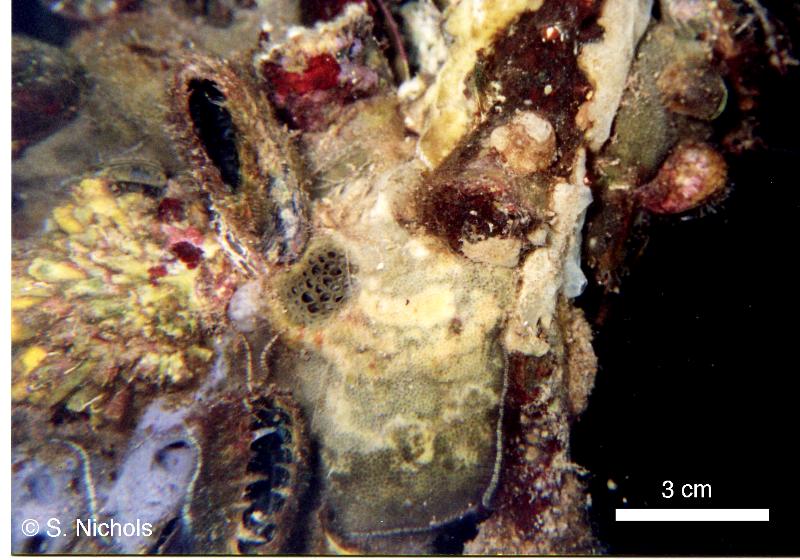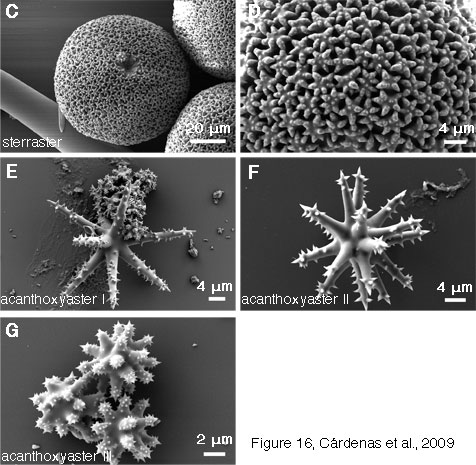| Submitted |
| Geodia papyracea |
| 2000-03-07 |
| Solarte, Bocas del Toro, Panama (9° 18' 21'' N, 82° 10' 23'' W) |
| 2m |
| Scott Nichols |
| UMPCW921 |
| University of California Museum of Paleontolo |
| Ethanol |
| Scott Nichols |
| 10th of March 2008 |
| Paco Cárdenas |
Morphological description (show/hide)
| Massive | | Whitish, green tinges. | | Whitish | | Uniporal, grouped in an oscular area | | Oxeas I and plagiotriaenes are positioned under the cortex, more or less radially. The plagiotrianes usually cross the cortex so that the cladomes end up in the ectocortex or at the surface of the cortex. The radial arrangement of megascleres is less obvious 1 mm under the cortex. Oxyasters I, oxyasters II and strongylasters can be found in the whole choanosome, as well as developing sterrasters. Oxeas II, smaller than oxeas I, are only found in the choanosome. | | The cortex is 480–840 µm thick and composed of a thin ectocortex of strongylasters (0–72 µm) and a thicker endocortex made of sterrasters (480–840 µm). The cortex is easily torn and detachable from the choanosome. | | (a) oxeas I, stout, straight or slightly bent, length: 651–1039–1248 µm; width: 7–24.3–29 µm. (b) oxeas II, rare, sometimes with strongyle ends, usually straight, length: 95–124.3–244 µm; width: 1–2–3 µm (N=14). (c) plagiotriaenes, rhabdome length: 641–962.7–1080; rhabdome width: 13–24.6–34 µm; clad length: 57–97.1–132 µm. (d) anatriaenes, rare, rhabdome length: 354–633.2–885 µm (N=5); rhabdome width: 2.5–3.2–4 µm (N=8); clad length: 5–13.8–27 µm (N=8). (e) mesoprotriaenes, very rare, rhabdome length: 632 µm (N=1); rhabdome width: 3 µm (N=1); clad length: 9–16 µm (N=2). | | (f) sterrasters (Fig. C–D), subglobular, with warty 4–7 branched rosettes at their surface (diameter: ca 4 µm), length: 65–71.6–77 µm; width: 63–70.3–75 µm; thickness: 50–55.9–61 µm. (g) acanthoxyasters I (Fig. E), 9–12 thin actines, center more or less developed, diameter: 22–27.5–36 µm. (h) acanthoxyasters II (Fig. F), with large centrum and thicker actines than acanthoxyasters I, 9–17 actines, less common than acanthoxyasters I. diameter: 14–23–29 µm. (i) acanthostrongylasters (Fig. G), 14–20 actines, diameter: 3–4.9–8.8 µm. |
|
Reference (show/hide)
| Nichols, S.A. (2005) An evaluation of support for order-level monophyly and interrelationships within the class Demospongiae using partial data from the large subunit rDNA and cytochrome oxidase subunit I. Molecular Phylogenetics and Evolution, 34, 81-96. |
| Cárdenas, P., Menegola, C., Rapp, H.T. & DÃaz, M.C. (2009) Morphological description and DNA barcodes of shallow-water Tetractinellida (Porifera: Demospongiae) from Bocas del Toro, Panama, with description of a new species. Zootaxa, 2276, 1-39. |
| Cárdenas, P., Rapp, H.T., Schander, C. & Tendal, O.S. (2010) Molecular taxonomy and phylogeny of the Geodiidae (Porifera, Demospongiae, Astrophorida) — combining phylogenetic and Linnaean classification. Zoologica Scripta, 39, 89-106. |
|





